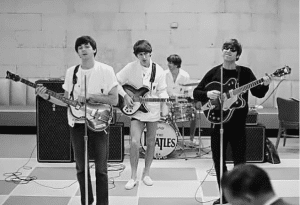’80s Rock Songs That Haven’t Aged as Well as We Remember

via @TheAerosmithVault / YouTube
Back in the neon glow of the 1980s, rock music reigned supreme. It was the soundtrack to high school dances, late-night parties, and endless car rides, blasting from cassette decks and MTV screens. The hooks were irresistible, the choruses unforgettable — and most of us never stopped to think too hard about what we were actually singing along to.
Looking back now, though, some of those chart-topping anthems don’t sound quite the same. Beneath the slick production and big hair bravado were lyrics that, by today’s standards, range from awkward to downright uncomfortable. Themes of obsession, predatory behavior, and gender stereotypes slipped through the cracks — not because they were subtle, but because the decade’s energy and excess often drowned out the unease.
It’s a reminder that nostalgia can blur the edges of what we once accepted without question. The ’80s gave us countless rock classics, but a few of them haven’t aged gracefully. Whether through outdated attitudes or questionable storytelling, these songs reveal just how much the times — and our tolerance — have changed.
“Into the Night” – Benny Mardones (Never Run, Never Hide)
At first listen, “Into the Night” sounds like a sweeping rock ballad fit for late-night drives and candlelit nostalgia. Its lush production and soaring vocals make it one of those songs that could easily slip under your moral radar. But once you pay attention to the lyrics, the entire illusion collapses. Benny Mardones opens with a line that’s impossible to ignore: “She’s just sixteen years old / Leave her alone, they say.” And yet, instead of taking that advice, he doubles down.
The song’s narrative centers on a grown man obsessed with a teenage girl, claiming he’d “wait till the end of time” for her while fantasizing about flying away with her “into the night.” It’s framed as tragic devotion, but it reads as a full-blown confession. What makes it more unsettling is how easy it is to get lost in its emotional intensity — the melody’s power masks its disturbing premise.
Still, audiences of the ’80s didn’t seem to mind. “Into the Night” hit the Billboard charts twice in the same decade — once in 1980 and again in 1989 — proving that a good hook can make listeners overlook almost anything. Mardones later tried to reframe the song as a story about helping a young neighbor after her father left, but that only made things murkier. Today, it stands as one of the creepiest examples of how rock’s romanticism sometimes strayed into deeply uncomfortable territory.
“Every Breath You Take” – The Police (Synchronicity)
It’s hard to imagine a wedding playlist without “Every Breath You Take.” The song’s calm rhythm, minimalist melody, and Sting’s soothing voice have led generations to mistake it for a love song. But behind its soft glow lies one of the most quietly sinister tracks ever to top the charts. Listen closer, and you’ll find not devotion, but surveillance — a narrator fixated on another person’s every move, breath, and smile.
When The Police released it in 1983, it soared to number one and stayed there for eight weeks in the U.S., becoming the band’s biggest hit. Fans clung to its romantic surface, but Sting himself was baffled by the misinterpretation. He has often said it’s about control and obsession — the kind that makes your skin crawl when viewed through the lens of real-life stalking and domestic abuse.
Decades later, its meaning has aged like sour milk. The era of big hair and bigger egos might have blurred its darkness, but time has stripped away the gloss. “Every Breath You Take” isn’t the promise of eternal love people once thought — it’s a warning about obsession disguised as tenderness. And yet, even with that awareness, millions still stream it today, proving that sometimes nostalgia wins out over unease.
“I Can’t Drive 55” – Sammy Hagar (VOA)
Sammy Hagar’s “I Can’t Drive 55” was a perfect anthem for the carefree chaos of the mid-’80s — a time when speed limits were meant to be broken and rules were just suggestions. Its rebellious hook and roaring guitars turned defiance into a rallying cry, making it a staple for every wannabe outlaw behind the wheel. But what sounded like harmless fun back then feels a little tone-deaf now.
Released in 1984, the song was inspired by Hagar’s real-life frustration at being ticketed for driving 62 mph on a California freeway. His outrage turned into a charting single that celebrated speeding as a kind of personal freedom. The problem? High-speed crashes were on the rise, and by the time the national speed limit was repealed a decade later, fatalities followed suit. The culture that once laughed at danger was suddenly forced to reckon with its cost.
Of course, no one’s blaming Hagar for modern road safety issues. But when cars now come equipped with self-driving tech and crash-avoidance systems, his open-road rebellion feels quaint at best — and reckless at worst. The song remains a symbol of a bygone era when adrenaline mattered more than caution, and that, in hindsight, hasn’t exactly aged gracefully.
“Dude (Looks Like a Lady)” – Aerosmith (Permanent Vacation)
In 1987, Aerosmith roared back into the mainstream with “Dude (Looks Like a Lady),” a song that seemed like harmless rock ’n’ roll fun — a little tongue-in-cheek, a little wild. The catchy horns, swaggering vocals, and unforgettable chorus made it one of their biggest hits, later finding new life in Mrs. Doubtfire. But time has a way of changing the way we hear things. What once sounded playful now feels cringeworthy, even cruel.
The song was born after Steven Tyler mistook a member of Mötley Crüe for a woman, leading to lyrics about attraction and confusion. While meant to be humorous, the joke came at the expense of anyone who didn’t fit rigid gender norms. Decades later, in an era more aware of transgender rights and representation, the track’s humor feels out of step — its refrain echoing as a taunt rather than a wink.
Aerosmith might not have intended harm, but intent doesn’t erase impact. “Dude (Looks Like a Lady)” has lingered in pop culture as both a bop and a reminder of how casually mockery once passed for amusement. Today, it’s a relic — a high-energy anthem that’s hard to dance to without wincing a little.
“Seventeen” – Winger (Winger)
If you’ve ever wondered what the darker side of the hair-metal era looked like, Winger’s “Seventeen” is Exhibit A. Released in 1989, the song proudly glorifies the idea of an adult rock star pursuing a teenage girl — and it doesn’t even try to be subtle. With lyrics like “Daddy says she’s too young, but she’s old enough for me,” it’s a window into the era’s worst excesses, where taboo topics were shrugged off as part of the rock lifestyle.
At the time, the track was treated as cheeky rebellion — a song about lust and danger wrapped in a power riff. But through a modern lens, it reads like a confession of entitlement and predation. It shifts the blame by portraying the teen as the instigator, which makes it all the more disturbing. What passed for fun in the MTV era now feels deeply uncomfortable, especially for listeners who are parents themselves.
Despite its sleaziness, “Seventeen” climbed the Billboard charts and cemented Winger’s brief fame. VH1 even ranked it among the “Greatest Hard Rock Songs” — a dubious badge of honor that says more about the decade than the music. These days, the song isn’t celebrated so much as side-eyed, standing as a loud reminder that not every ’80s anthem deserves a nostalgic comeback.
















